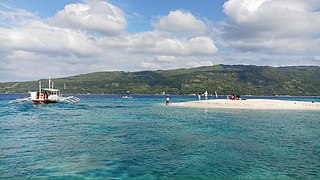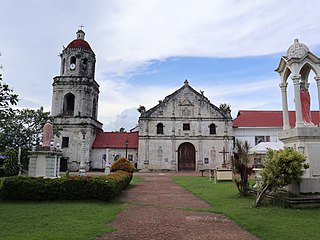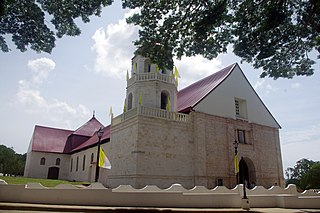
Boljoon, officially the Municipality of Boljoon, is a municipality in the province of Cebu, Philippines. According to the 2020 census, it has a population of 17,525 people.

Oslob, officially the Municipality of Oslob, is a municipality in the province of Cebu, Philippines. According to the 2020 census, it has a population of 29,264 people.

The Minor Basilica and Parish of San Sebastian, also known as the Shrine of Our Lady of Mount Carmel and commonly known as San Sebastian Church or San Sebastian Basilica, is a minor basilica of the Roman Catholic Church in Manila, Philippines. It is under the jurisdiction of the Archdiocese of Manila.

The National Museum of the Philippines is an umbrella government organization that oversees a number of national museums in the Philippines including ethnographic, anthropological, archaeological, and visual arts collections. From 1973 until 2021, the National Museum served as the regulatory and enforcement agency of the government of the Philippines in the restoring and safeguarding of significant cultural properties, sites, and reservations throughout the Philippines. The mandate has since been transferred to the National Commission for Culture and the Arts.

Immaculate Conception Cathedral, commonly known as Pasig Cathedral, is a Roman Catholic church located in Plaza Rizal, Barangay Malinao, Pasig in Metro Manila, Philippines. It is the mother church, and serves as the episcopal seat of the Bishop of Pasig and is one of the oldest structures in the city.

The Basílica Minore del Santo Niño de Cebú, alternatively known as the Minor Basilica of the Holy Child or simply Santo Niño Basilica, is a minor basilica in Cebu City in the Philippines that was founded in 1565 by Fray Andrés de Urdaneta and Fray Diego de Herrera. It is the oldest Roman Catholic church in the country, allegedly built on the spot where the image of the Santo Niño de Cebú was found during the expedition of Miguel López de Legazpi.

The Archdiocesan Shrine of San Miguel Arcangel, commonly known as Argao Church, is a Roman Catholic church in Argao, Cebu, Philippines. It is under the jurisdiction of the Archdiocese of Cebu. The municipality of Argao was established as a parish in 1703 under the Augustinian order. To serve the parochial needs of its people, a stone church was constructed in 1734 and was completed in 1788. The church was dedicated to Saint Michael the Archangel.

Santa Cruz Parish Church, also known as Holy Cross Parish Church and Maribojoc Church, is a Roman Catholic parish church in the municipality of Maribojoc, Bohol, Philippines, under the Diocese of Tagbilaran. The parish was first established by the Jesuits in 1767 or 1768 with Father Juan Soriano, SJ as its first parish priest. The Augustinian Recollects later administered the community until 1898.

The Fort of Saint Vincent Ferrer or commonly known as Punta Cruz Watchtower (Tagalog: Bantayan ng Punta Cruz) is a Spanish colonial era watchtower located at the western tip of the municipality of Maribojoc, Bohol, Philippines. Also known as Maribojoc Watchtower because of its geographical location, it is located three kilometers (1.9 mi) away from Maribojoc Church. It is known for being the "only perfect isosceles triangle" tower-fort structure in the Philippines.

Saint Catherine of Alexandria Parish Church, also known as the Shrine of Our Lady of Namacpacan and Namacpacan Church, is a Roman Catholic church located in Luna, La Union, Philippines under the jurisdiction of the Diocese of San Fernando de La Union. Once called Luna Church, its titular is Saint Catherine of Alexandria. Built in 1690, it is also known as the shrine for the image of Our Lady of the Immaculate Conception of Namacpacan.

Saint Matthias Parish Church, commonly known as Tumauini Church, is a Roman Catholic church in the municipality of Tumauini, Isabela, Philippines, within the jurisdiction of the Diocese of Ilagan. It became a separate parish independent from Cabagan under the advocacy of Saint Matthias in 1751.

Immaculate Conception Parish Church, also known as La Purisima Concepcion de la Virgen Maria Parish Church and Baclayon Church, is a Roman Catholic church in the municipality of Baclayon, Bohol, Philippines within the jurisdiction of the Diocese of Tagbilaran. Baclayon was founded by the Jesuit priest Juan de Torres and Gabriel Sánchez in 1596, and became the oldest Christian settlement in Bohol. It was elevated as a parish in 1717 and the present coral stone church was completed in 1727. The Augustinian Recollects succeeded the Jesuits in 1768 and heavily renovated the church since then.

San Pedro Apostol Parish Church, commonly known as Loboc Church and alternatively as the Diocesan Shrine of Our Lady of Guadalupe in Extremadura, is a Roman Catholic church in the municipality of Loboc, Bohol, Philippines, within the jurisdiction of the Diocese of Tagbilaran.

Immaculate Conception Parish Church, commonly known as Guiuan Church, is a Roman Catholic church in the municipality of Guiuan, Eastern Samar, Philippines, within the jurisdiction of the Diocese of Borongan.

San Isidro Labrador Parish Church, commonly known as Lazi Church, is a Roman Catholic church in the municipality of Lazi, Siquijor, Philippines within the jurisdiction of the Diocese of Dumaguete. It became an independent parish in 1857 under the advocacy of Saint Isidore the Laborer.

Saint Ignatius of Loyola Parish Church, commonly known as Capul Church or Fuerza de Capul, is a Roman Catholic fortress church in the municipality of Capul, Northern Samar, Philippines within the jurisdiction of the Diocese of Catarman. It was first established as a mission station by the Jesuits in 1596 under the advocacy of Saint Ignatius of Loyola.

The National Shrine of Saint Joseph, commonly known as Mandaue Church, is a Roman Catholic parish church located at the center of Mandaue City, Philippines. It is under the jurisdiction of the Archdiocese of Cebu; its parish jurisdiction covers the civil barangays of Guizo, Centro, Looc, and Mantuyong.

Our Lady of the Pillar Parish Church, also known as the Virgin of the Pillar Parish Church or simply Sibonga Church, is a Roman Catholic church in Sibonga, Cebu, Philippines. It is under the jurisdiction of the Archdiocese of Cebu.

San Guillermo de Aquitania Parish Church, commonly known as Dalaguete Church, is a Roman Catholic church located in Dalaguete, Cebu, Philippines. Dedicated to the French saint William of Gellone, also known as William of Aquitaine, it is under the jurisdiction of the Archdiocese of Cebu. The church was constructed in 1802 and was completed in 1825.



























